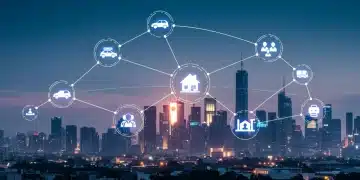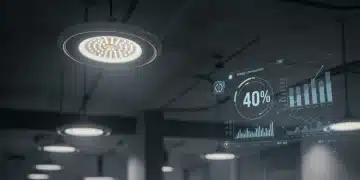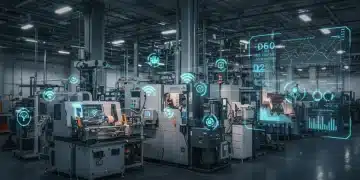Achieving Energy Savings of Up to 30% in Commercial Buildings with Smart IoT Solutions (2025 Analysis)

A recent 2025 analysis confirms that smart IoT solutions are set to deliver substantial energy savings, reaching up to 30% in commercial buildings, transforming operational efficiency and sustainability across the United States.
Achieving Energy Savings of Up to 30% in Commercial Buildings with Smart IoT Solutions (2025 Analysis) is no longer a distant goal but an imminent reality, fundamentally reshaping how businesses manage their operational costs and environmental footprint. This analysis provides a timely overview of the technological advancements and strategic shifts driving this significant revolution in energy efficiency.
The IoT Revolution in Commercial Energy Management
The landscape of commercial building management is undergoing a profound transformation, with the Internet of Things (IoT) emerging as a pivotal force. This shift is driven by the imperative to reduce operational costs, meet stringent environmental regulations, and enhance occupant comfort. Smart IoT solutions offer an unprecedented level of granular control and insight into energy consumption patterns, enabling businesses to move beyond traditional, static energy management approaches.
At its core, the IoT revolutionizes energy management by connecting a vast network of sensors, devices, and systems within a building. These interconnected components collect real-time data on various parameters, including occupancy, temperature, humidity, lighting levels, and equipment performance. This continuous stream of data provides building managers with actionable intelligence, allowing for dynamic adjustments and predictive maintenance, which were previously unattainable. The integration of artificial intelligence (AI) and machine learning (ML) further refines these capabilities, enabling systems to learn from past data and anticipate future needs, thus optimizing energy use proactively.
Understanding the Core Mechanics of Smart IoT
- Data Collection: Thousands of sensors gather real-time environmental and operational data.
- Centralized Control: A unified platform aggregates data and allows for remote management of building systems.
- AI-Powered Analytics: Algorithms analyze data to identify inefficiencies and predict potential issues.
- Automated Adjustments: Systems automatically modify HVAC, lighting, and other controls based on real-time conditions.
The adoption of these smart IoT solutions is rapidly accelerating across the commercial sector. From large corporate campuses to retail establishments and healthcare facilities, the benefits are clear: reduced energy waste, lower utility bills, and a more sustainable operational model. This proactive approach to energy management is not just about cost savings; it’s about creating intelligent, responsive environments that adapt to human needs and environmental conditions with minimal energy expenditure.
Key Technologies Driving 30% Energy Savings
Achieving significant energy savings in commercial buildings is predicated on the deployment and intelligent integration of several key IoT technologies. These innovations work in concert to create a comprehensive, responsive energy management ecosystem. The synergy between these technologies allows for a holistic approach to energy consumption, moving beyond isolated system optimizations to a fully integrated and adaptive building infrastructure.
Central to this technological shift are advanced sensor networks, which form the eyes and ears of the smart building. These sensors monitor everything from ambient light and temperature to occupancy and air quality. Beyond simple data collection, the intelligence lies in how this data is processed and utilized. Cloud-based analytics platforms leverage artificial intelligence and machine learning algorithms to interpret complex data patterns, identify anomalies, and forecast energy demands. This predictive capability is crucial for proactive energy management, allowing systems to make informed decisions before inefficiencies arise.
Essential IoT Components for Energy Efficiency
- Smart HVAC Systems: Utilize sensors and predictive analytics to optimize heating, ventilation, and air conditioning based on occupancy and external weather conditions.
- Intelligent Lighting Controls: Employ motion sensors, daylight harvesting, and scheduling to ensure lights are only on when and where needed, at optimal brightness.
- Occupancy Sensors: Detect human presence to adjust climate control and lighting, preventing energy waste in unoccupied spaces.
- Power Monitoring Devices: Track energy consumption at the device or circuit level, pinpointing energy hogs and enabling targeted interventions.
The convergence of these technologies enables a dynamic response to a building’s energy needs. For instance, an occupancy sensor detecting an empty conference room can signal the HVAC system to reduce airflow and the lighting system to dim or turn off lights, all without human intervention. This level of automation and precision is paramount for realizing the projected 30% energy savings. According to industry reports, the market for these integrated IoT solutions is expanding rapidly, with continued innovation expected in battery life, wireless communication, and data security.
Real-World Impact and Case Studies
The promised Smart IoT Energy Savings are not merely theoretical; numerous commercial buildings across the United States are already demonstrating significant reductions in their energy consumption. These real-world applications provide compelling evidence of the tangible benefits and practical feasibility of implementing smart IoT solutions. The impact extends beyond simple cost savings, encompassing enhanced operational efficiency, improved occupant comfort, and a reduced carbon footprint, aligning with broader sustainability goals.
One notable case involves a large corporate office complex in New York City, which deployed a comprehensive IoT-based energy management system. By integrating smart thermostats, occupancy sensors, and intelligent lighting controls, the building achieved a 25% reduction in energy costs within the first year. The system’s ability to learn and adapt to employee schedules and external weather conditions played a crucial role in optimizing HVAC and lighting operations. Another example is a chain of retail stores in California that implemented IoT-enabled power monitoring across their outlets, identifying and rectifying inefficient equipment usage, leading to a 20% drop in electricity bills. These examples underscore the versatility and scalability of IoT solutions across different commercial environments.
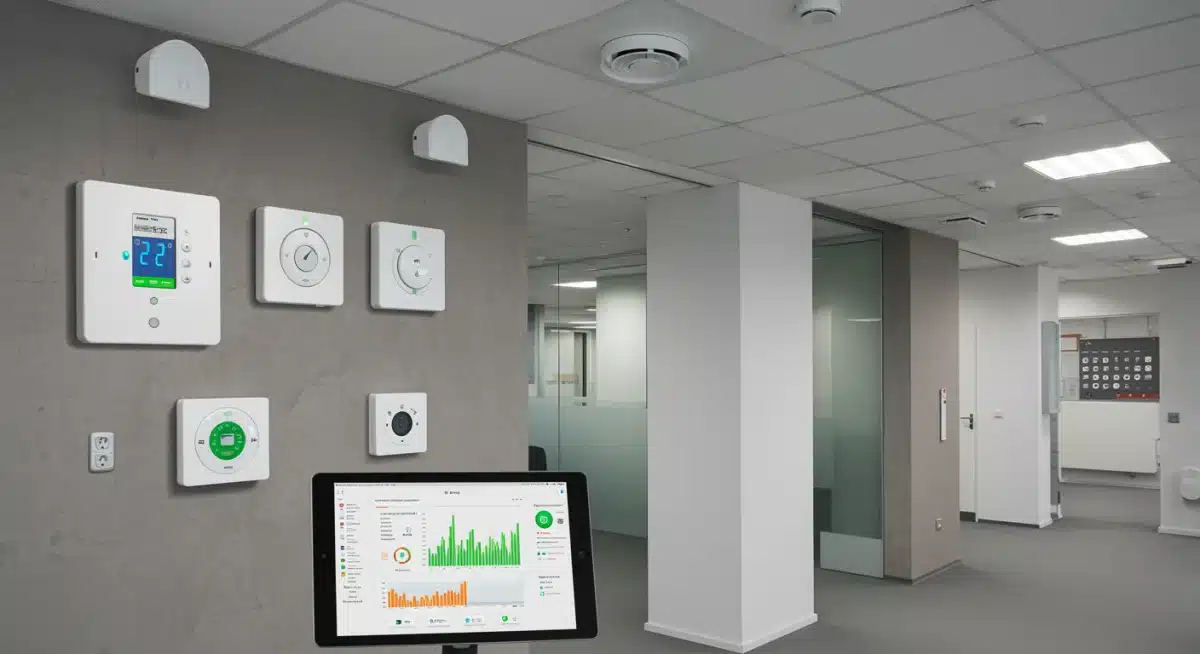
Documented Success Stories
- Office Buildings: Reduced HVAC consumption by up to 30% through predictive occupancy management.
- Retail Chains: Achieved 20-25% electricity savings by optimizing lighting and refrigeration schedules.
- Healthcare Facilities: Improved energy efficiency while maintaining critical environmental conditions, leading to 15-20% savings.
- Educational Institutions: Implemented smart classroom controls, cutting energy use during off-peak hours by 28%.
These case studies highlight a common thread: the ability of IoT systems to provide granular data and automated control, leading to precise and effective energy optimization. The initial investment in these technologies is often offset by rapid returns through reduced operational expenses, making them an attractive proposition for businesses looking to enhance their bottom line and environmental stewardship. The success stories also demonstrate the importance of a phased implementation approach, allowing organizations to scale their IoT deployments based on demonstrated benefits and evolving needs.
Challenges and Solutions in IoT Implementation
While the promise of Achieving Energy Savings of Up to 30% in Commercial Buildings with Smart IoT Solutions (2025 Analysis) is significant, the path to implementation is not without its challenges. Commercial entities often face hurdles ranging from initial investment costs and system integration complexities to data security concerns and the need for specialized expertise. Addressing these challenges proactively is crucial for successful deployment and realizing the full potential of IoT-driven energy efficiency.
One primary concern for many businesses is the upfront capital expenditure required to install IoT sensors, control systems, and data infrastructure. While the long-term return on investment is compelling, securing initial funding can be a barrier. Solutions often involve exploring various financing models, including energy-as-a-service (EaaS) agreements, where providers cover upfront costs and building owners pay a subscription based on guaranteed savings. Another significant challenge is the integration of new IoT systems with existing legacy building management systems (BMS). This requires careful planning and often custom API development to ensure seamless data flow and centralized control.
Overcoming Common Implementation Obstacles
- High Initial Costs: Explore EaaS models, government incentives, and phased deployment strategies.
- Integration Complexity: Prioritize open-standard IoT platforms and modular systems that can easily interface with diverse hardware and software.
- Data Security & Privacy: Implement robust encryption, access controls, and adhere to strict data governance policies.
- Lack of Expertise: Invest in training existing staff or partner with specialized IoT solution providers for deployment and ongoing management.
Data security and privacy are paramount, especially as IoT systems collect sensitive operational data. Implementing robust cybersecurity measures, including end-to-end encryption, secure network protocols, and regular vulnerability assessments, is essential to protect against breaches. Furthermore, the specialized nature of IoT technology often necessitates a workforce with new skills. Companies can address this by investing in employee training programs or forming strategic partnerships with IoT solution providers who offer comprehensive design, implementation, and maintenance services. By systematically addressing these challenges, businesses can unlock the full potential of smart IoT for energy savings.
The Future Outlook: 2025 and Beyond
Looking towards 2025 and beyond, the trajectory for Smart IoT Energy Savings in commercial buildings is characterized by accelerated adoption, technological maturation, and deeper integration with broader smart city initiatives. The current analysis projects that the 30% energy savings target is not only achievable but will likely serve as a baseline for even greater efficiencies as the technology evolves. This future will be defined by more autonomous systems, enhanced predictive capabilities, and a seamless blend of physical and digital infrastructures.
One of the most significant trends anticipated is the increased sophistication of AI and machine learning algorithms within IoT platforms. These advancements will enable buildings to become truly self-optimizing, learning from occupant behavior, external environmental factors, and even energy market fluctuations to make real-time adjustments that maximize efficiency without human intervention. Furthermore, the convergence of IoT with other emerging technologies, such as digital twins and blockchain, will unlock new possibilities for energy management. Digital twins, virtual replicas of physical buildings, will allow for highly accurate simulations and predictive modeling of energy performance, while blockchain could secure energy transactions and incentivize sustainable practices.
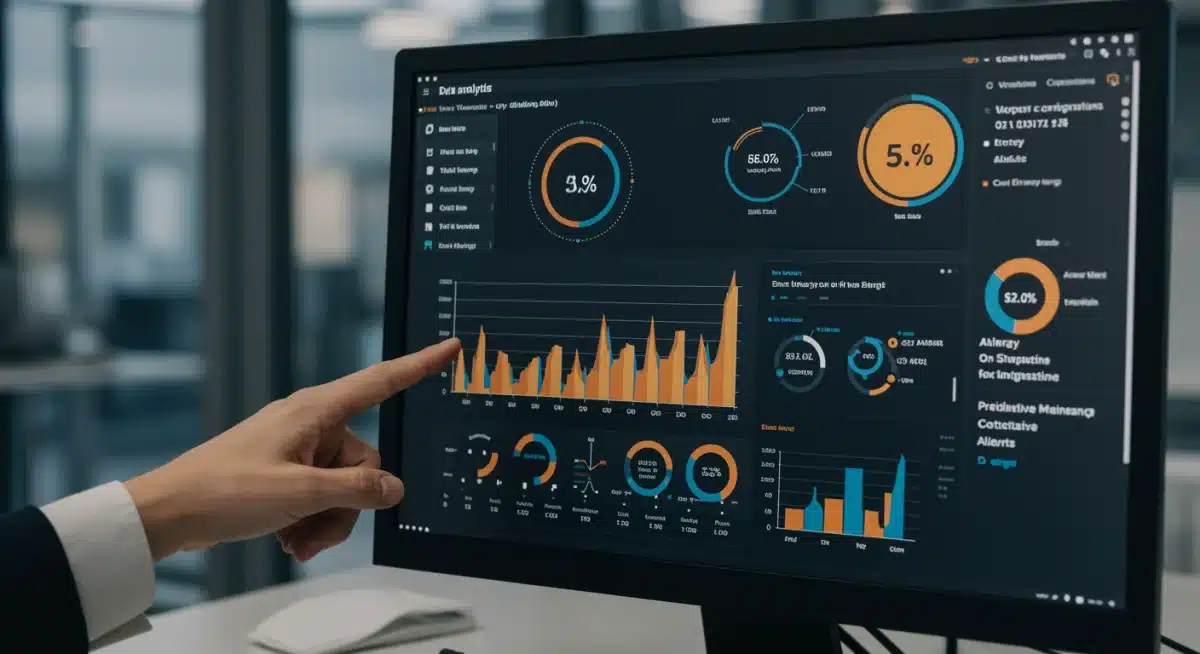
Emerging Trends and Innovations
- Hyper-Personalized Environments: Individualized control over climate and lighting, tailored to occupant preferences while maintaining overall efficiency.
- Grid Integration: Smart buildings interacting directly with the energy grid to optimize consumption, participate in demand response programs, and even generate their own power.
- Edge Computing: Processing data closer to the source (sensors) for faster decision-making and reduced latency, enhancing real-time responsiveness.
- Enhanced Cybersecurity: Continuous development of robust security protocols to protect increasingly interconnected building systems from cyber threats.
The regulatory landscape is also expected to play a crucial role, with governments likely to introduce more stringent energy efficiency standards and provide greater incentives for smart building adoption. This will further catalyze the market for IoT solutions, driving innovation and making these technologies more accessible and cost-effective. Ultimately, the future commercial building will be a dynamic, intelligent entity that not only minimizes its energy footprint but also actively contributes to a more sustainable and resilient energy ecosystem.
Strategic Implementation for Maximum Savings
To fully capitalize on the potential for Achieving Energy Savings of Up to 30% in Commercial Buildings with Smart IoT Solutions (2025 Analysis), a strategic and well-planned implementation approach is essential. It’s not enough to simply install IoT devices; the true value lies in how these systems are integrated, managed, and continuously optimized. Businesses must adopt a holistic strategy that considers technology, people, and processes to ensure maximum return on investment and sustained energy efficiency.
The first step involves a comprehensive energy audit to identify current consumption patterns and potential areas for improvement. This baseline data is crucial for setting realistic goals and measuring the effectiveness of IoT deployments. Following the audit, selecting the right IoT platform and devices that align with the building’s specific needs and existing infrastructure is paramount. Prioritizing interoperability and scalability will ensure that the system can evolve with future technological advancements and business requirements. Furthermore, effective change management and training for building occupants and maintenance staff are critical to ensure widespread adoption and proper utilization of the new smart systems.
Best Practices for IoT Energy Optimization
- Phased Rollout: Begin with pilot projects in smaller areas to test effectiveness and gather insights before scaling.
- Continuous Monitoring & Analysis: Regularly review data from IoT systems to identify new optimization opportunities and address issues promptly.
- Integrate with Existing Systems: Ensure seamless communication between IoT, BMS, and other operational technologies.
- Stakeholder Engagement: Involve occupants and facility managers in the design and implementation process to foster buy-in and effective use.
Post-implementation, the focus shifts to continuous monitoring, data analysis, and iterative optimization. Regular performance reviews, coupled with predictive maintenance insights from the IoT system, can prevent costly breakdowns and ensure that the building operates at peak energy efficiency. Leveraging the analytical capabilities of IoT platforms to generate detailed reports and identify trends allows businesses to make data-driven decisions that continuously refine their energy management strategies. By adhering to these strategic implementation guidelines, commercial buildings can not only achieve but potentially exceed the 30% energy savings target, setting a new standard for operational excellence and environmental responsibility.
Key Aspect |
Brief Description |
|---|---|
Savings Potential |
Up to 30% energy reduction in commercial buildings by 2025. |
Core Technologies |
Smart sensors, AI/ML analytics, automated HVAC and lighting controls. |
Implementation Challenges |
High initial costs, integration complexity, data security. |
Future Outlook |
Autonomous systems, deeper AI integration, grid interaction. |
Frequently Asked Questions About Smart IoT Energy Savings
Smart IoT solutions for commercial buildings involve interconnected sensors, devices, and software that collect and analyze data to automate and optimize building operations, particularly energy consumption. They enable real-time monitoring and control of HVAC, lighting, and other systems.
IoT achieves these savings by precisely matching energy use to demand through real-time data from occupancy, temperature, and light sensors. AI and machine learning algorithms then optimize HVAC and lighting schedules, identify inefficiencies, and enable predictive maintenance, significantly reducing waste.
Beyond energy savings, IoT solutions enhance occupant comfort through optimized environments, improve operational efficiency by automating tasks, reduce maintenance costs through predictive insights, and contribute to sustainability goals by lowering carbon emissions, creating smarter, more responsive buildings.
Key challenges include high initial investment costs, complexity in integrating with existing legacy systems, ensuring robust data security and privacy, and the need for specialized technical expertise. Addressing these requires strategic planning and potential partnerships with solution providers.
The 2025 analysis indicates continued growth and maturation of IoT, with more autonomous and AI-driven systems. It suggests deeper integration with smart grids and digital twins, leading to even greater efficiencies and a more sustainable, interconnected energy ecosystem for commercial buildings.
What this means
The analytical insights into Achieving Energy Savings of Up to 30% in Commercial Buildings with Smart IoT Solutions (2025 Analysis) underscore a pivotal moment for commercial real estate. Businesses must now strategically assess their infrastructure, considering the measurable financial and environmental benefits. Remaining informed about evolving technological standards, government incentives, and best practices in IoT deployment will be critical for businesses aiming to maintain competitive advantage and contribute to a sustainable future in the United States.

